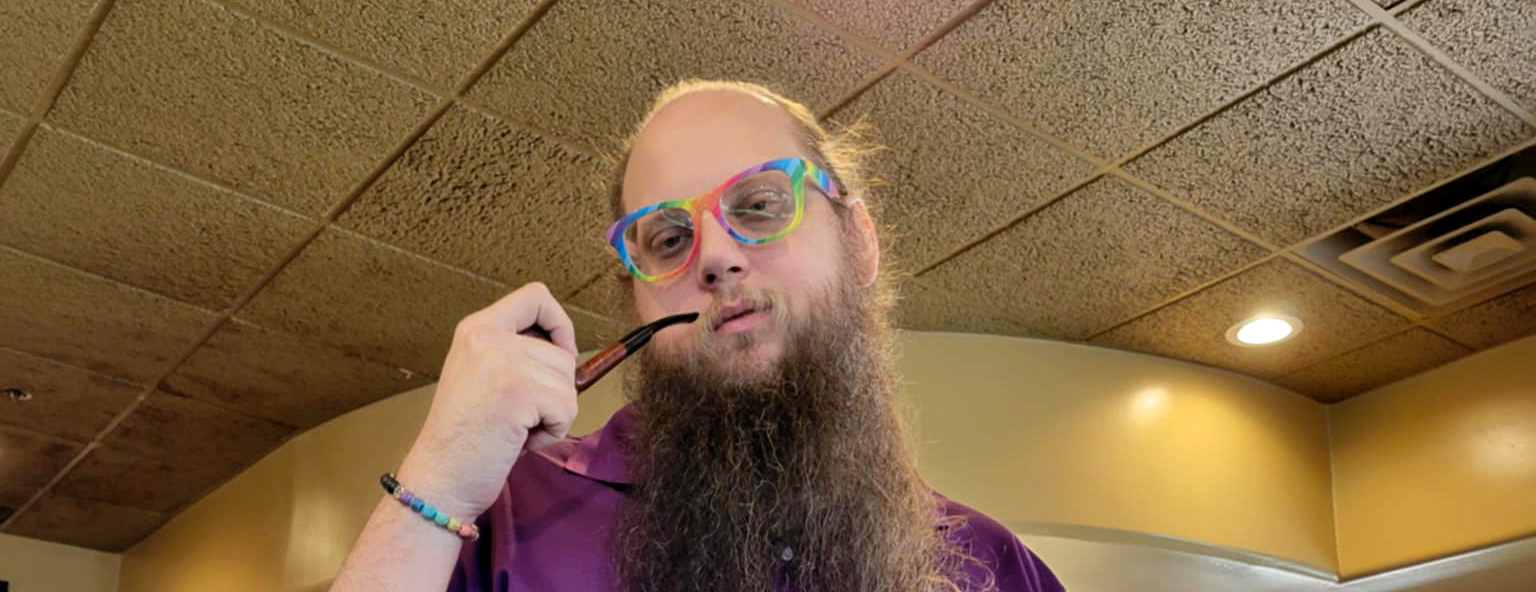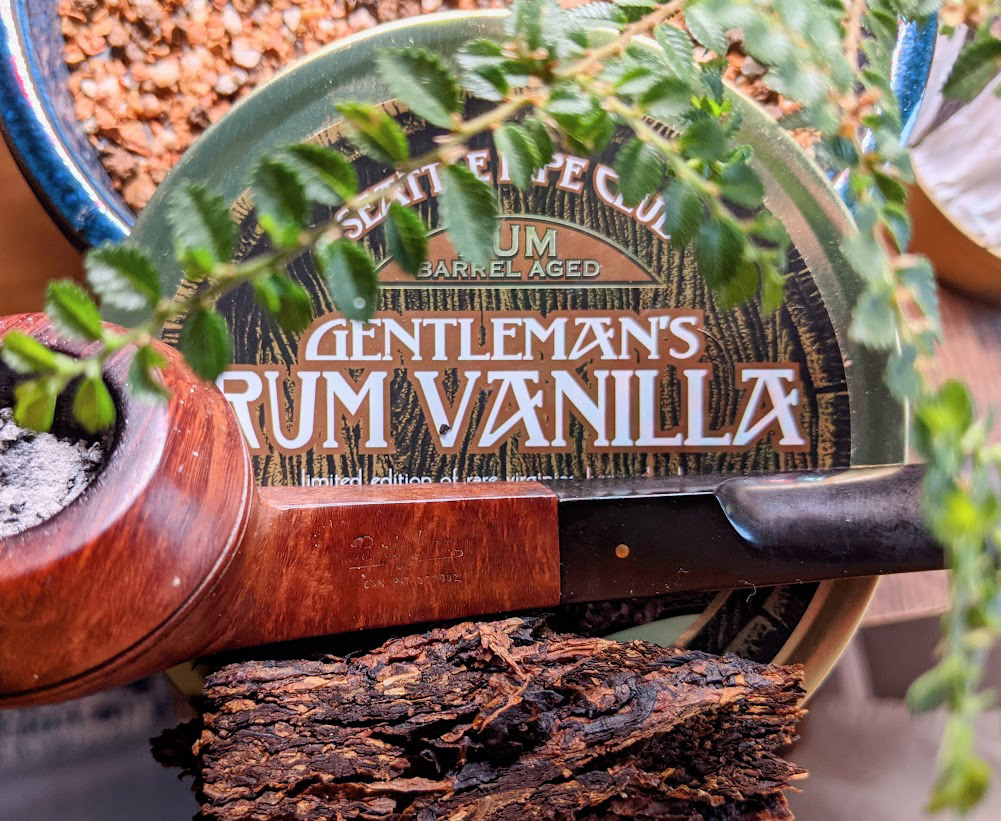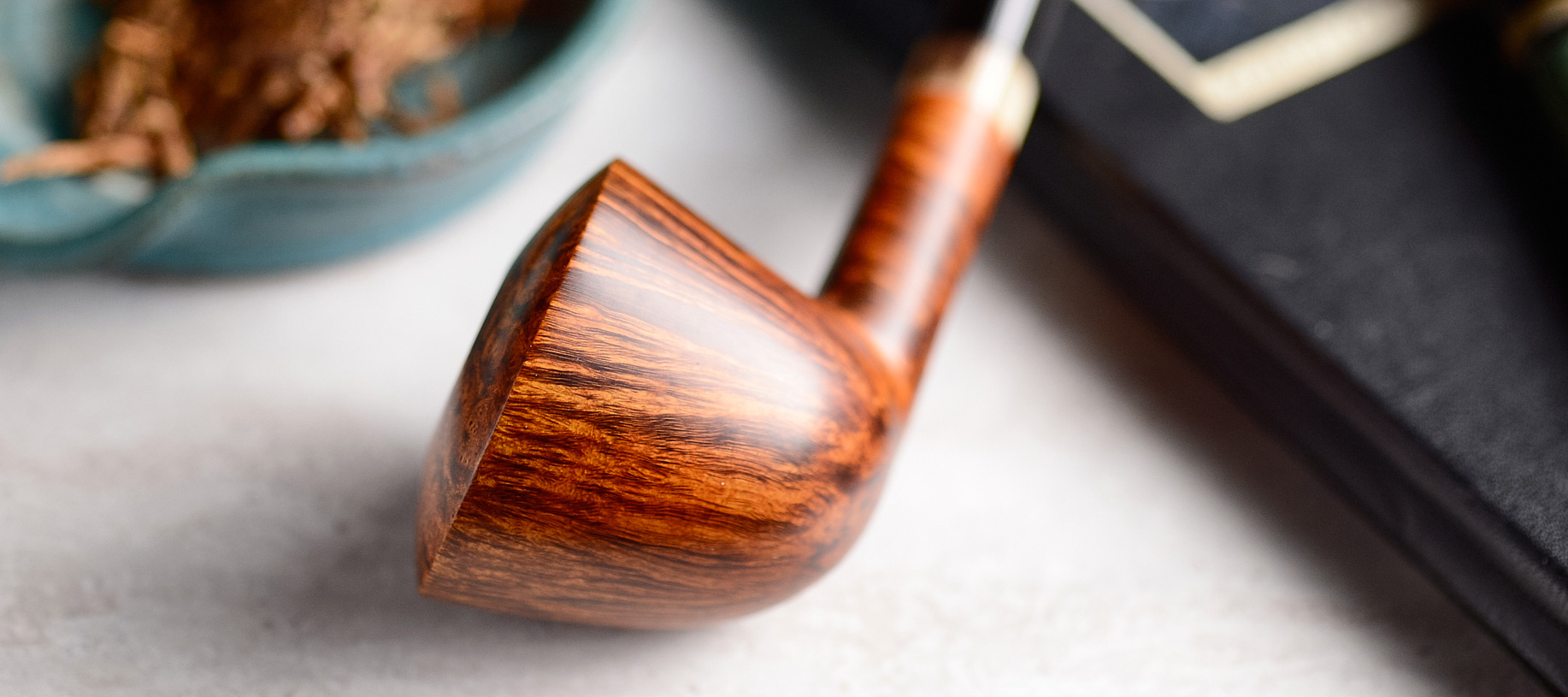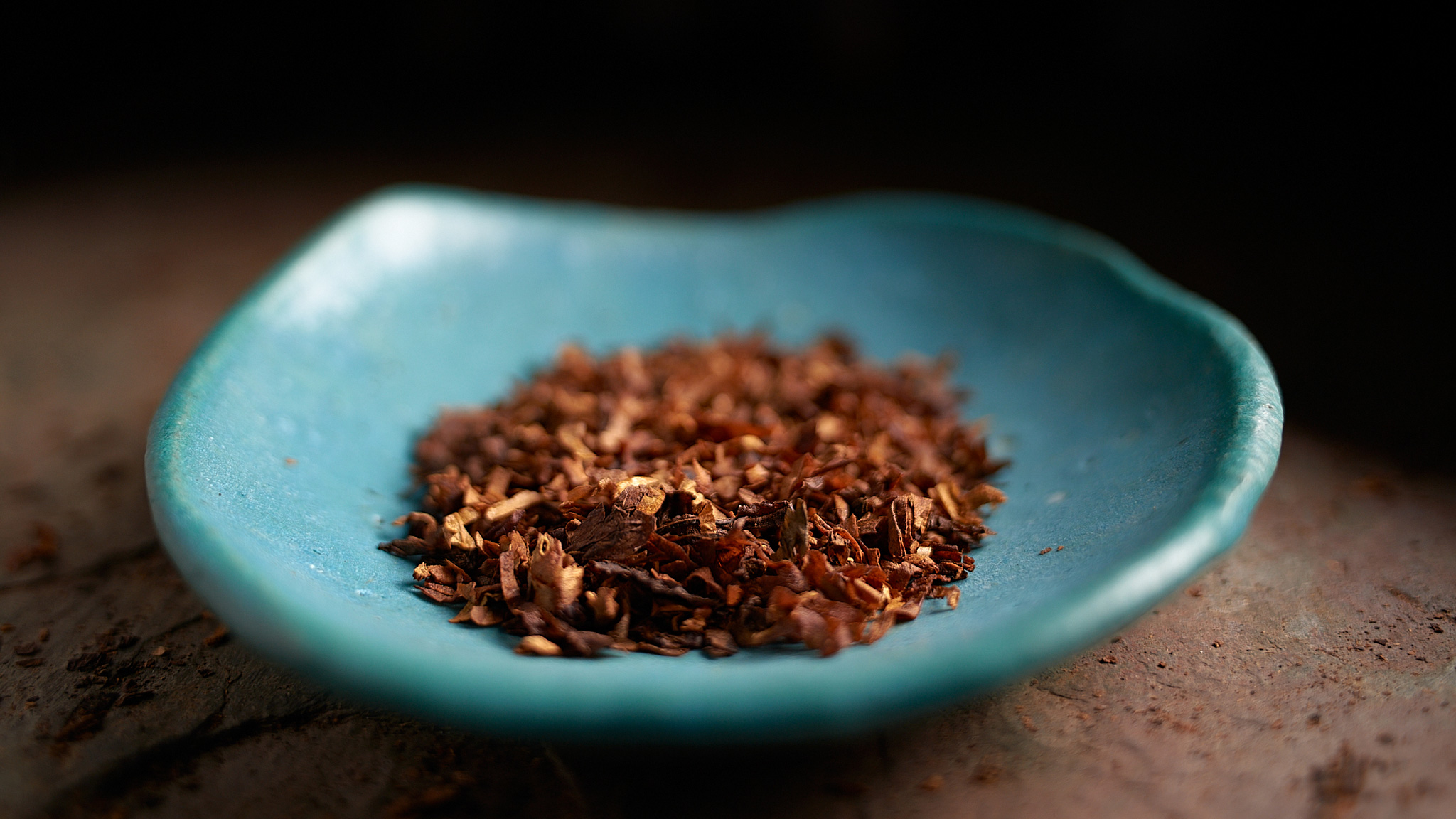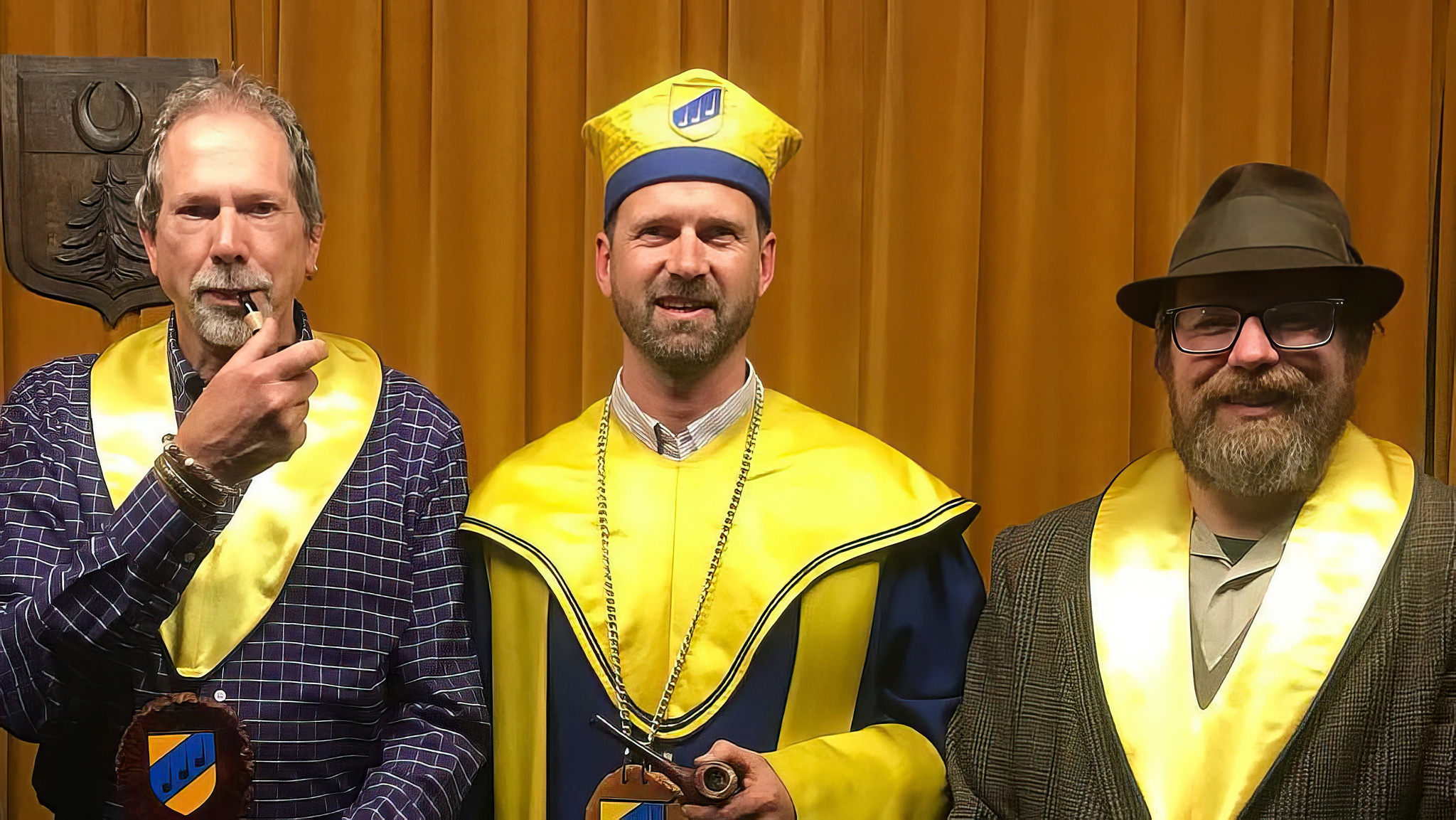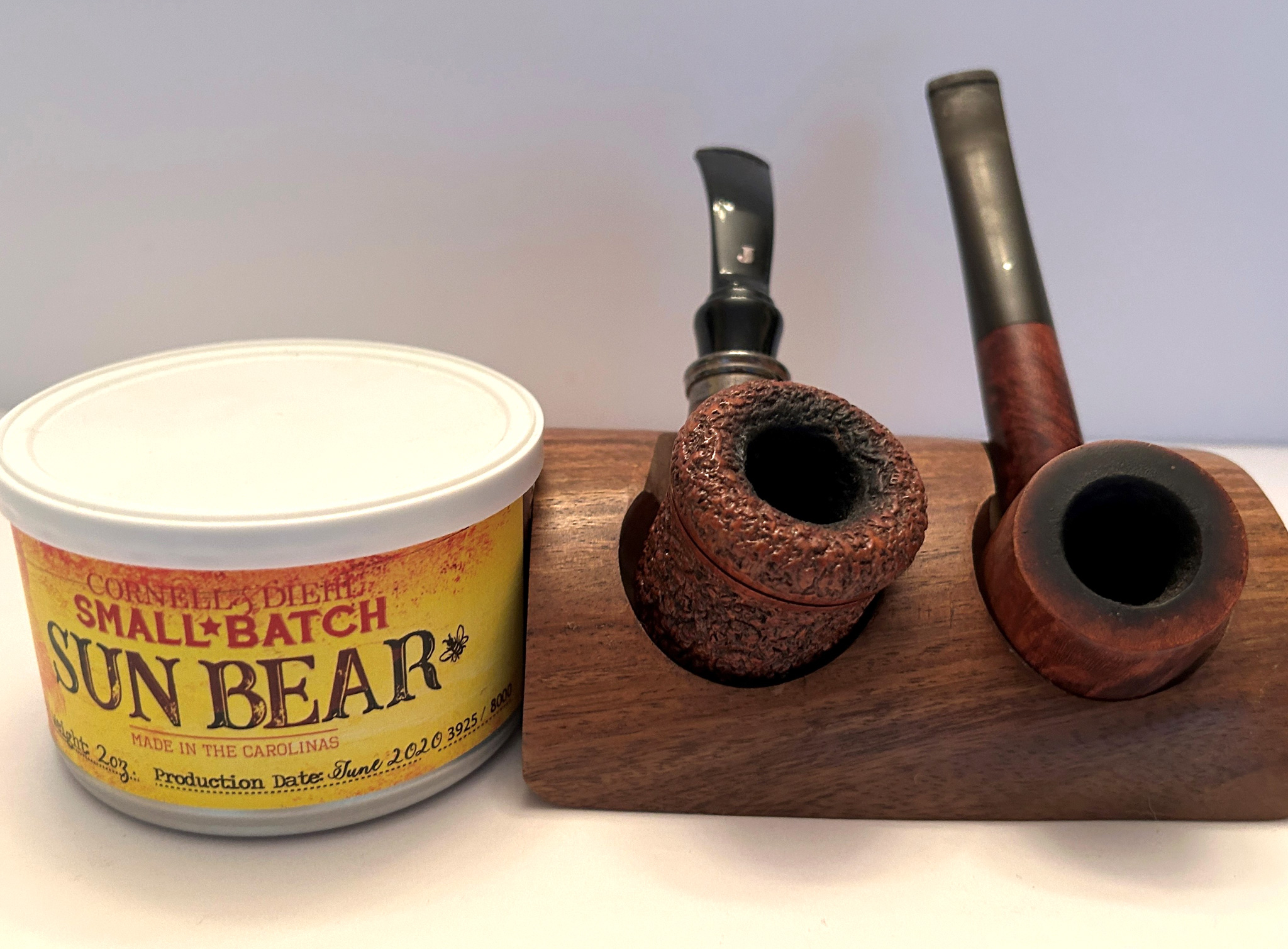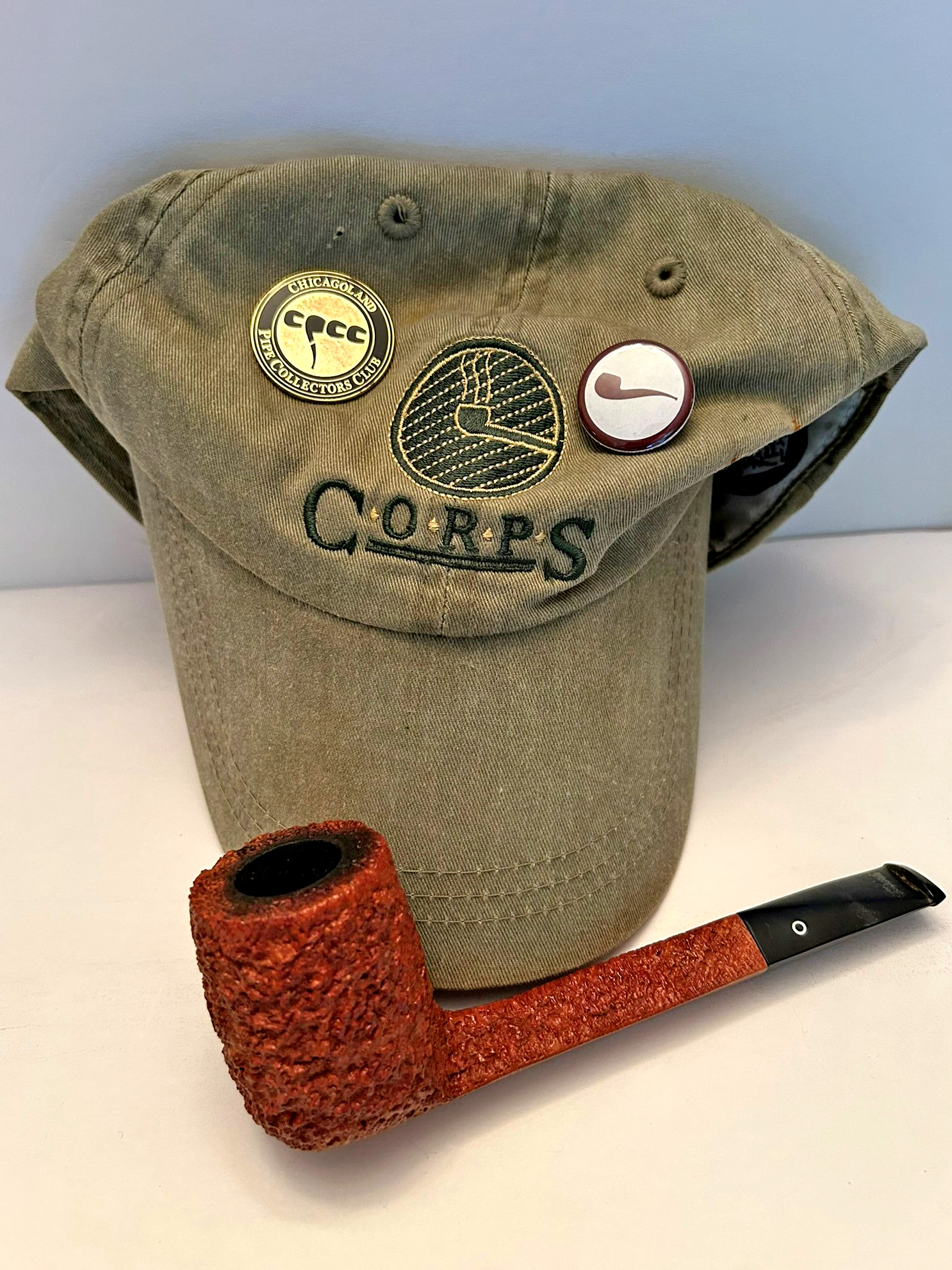Smokingpipes.com Updates
Radio Talk Show
- Pipes Magazine Radio Show Episode 631
Welcome to The Pipes Magazine Radio Show Episode 631. Our featured interview on tonight’s show is with pipe maker Dan Keller from Good Made Better. Dan is from South Dakota. Growing up working in the family hardware store where he was always finding solutions to fixing things, he ended up always wanting to make things. He now makes elegant handmade pens, pen holders, portable desks, blotters, blotting paper, book carry cases, and of course artisan pipes. At the top of the show we are continuing the virtual tour of Brian’s pipes with his “f#@k you pipes”.
- Pipes Magazine Radio Show Episode 630
Welcome to The Pipes Magazine Radio Show Episode 630! Our featured interview on tonight’s show is with Andrew Hopkins. Andrew is the General Manager of Stag Tobacconist in Scottsdale, AZ. He is the third generation in the business. His grandfather started with his store Phoenix Pipe Shop in 1974 in downtown Phoenix. It later changed names to Smoker’s Delight. He also owned Ye Olde Pipe & Tobacco Shoppe starting in 1980. Andrew’s father started in the business as a teenager helping out n the store in 1976. Andrew got into the business in 2007, and he has some great stories to tell as a third generation tobacconist. At the top of the show we will have an Ask the Tobacco Blender segment with Jeremy Reeves. Jeremy is the Head Blender at Cornell & Diehl, which is one of the most popular boutique pipe tobacco companies in the USA.
- Pipes Magazine Radio Show Episode 629
Welcome to The Pipes Magazine Radio Show Episode 629! Our featured interview on tonight’s show is with Danish Pipe Maker Mike Sebastian Bay. Mike got his start in pipe making when looking for someone to repair his father’s pipes in the Copenhagen area. He inadvertently found renowned pipe artisan Tom Eltang, and apprenticed under him for several years. He learned Tom’s signature rustication technique, and then made it his own. His pipe designs are also known for the poker shapes with “the bend” – after the forward tilt, there is another angle bent forward. At the top of the show, Brian will discuss everything about aging tobacco you will ever need to know.
Tobacco Reviews
- Pipe Force Episode II & Hogshead Bourbon Barrel Aged Reviews
We’re in the dog days of summer, and in the heat and humidity I find my palate tends to become as erratic as the extreme weather. To be more precise, my entire biochemistry is busily making the continual adjustments that keep this finely-tuned machine old jalopy of a body in top form hobbling along, and my taste buds are a good indicator that the system is preoccupied with regulating itself. Therefore it’s no surprise that McCranie’s Roanoke, the tobacco that I’d been favoring since the winter months and regularly returning to between other review blends, just wasn’t hitting the spot anymore. We live in fortunate times that present no shortage of novel and interesting blends to try, so some speculation toward new flavors is in order. This month’s spotlight will thus fall on a couple of summer sequels, of a sort: first, the latest installment of Per Jensen’s Pipe Force line, Episode II to be exact; second, a new incarnation of Seattle Pipe Club’s Hogshead, this time with a bourbon barrel-aged twist. Much like The Empire Strikes Back improved on the previous film in that series, Episode II is a generational improvement on the English profile offered in Episode I. To my personal taste, while I enjoyed Episode I quite a bit, it didn’t have a definable hook for me; this iteration of a similar ingredient list hits much closer to the mark. Here again it is a Latakia-forward mixture presented with Katerini concoctions and stoved tobaccos, but with more variety and, for my money, more interest. From the tin: A mellow, sweet mixture of Bright, Red, and Stoved Virginia offers the exceptional base for smokey Latakia, floral Kentucky, spice of Stoved Katerini and the ambrosial berry and spice of Katerini Perique. The result is a harmony of flavor in perfect balance. The bouquet in the tin is tart, heathery, and leathery, in equal proportion. The aroma is dry and smoky with clear clay overtones and, as advertised, faint berry notes from the tin. In the bowl the sweetness sneaks in immediately, displaying a wonderful synergy between the Katerini Perique (Periquini? Katerique?) and the Virginias, offering a flavor unique and quite apart from the usual raisiny range commonly found in Virginia / Perique meldings. Conversely, the Latakia’s smoky, burning-rubber character is also influenced by the Katerini, directing it toward a very pinyon-esque range of aroma that lingers distinctly the room note afterward. Speaking of room note, it can become rather tart after repeated bowls—advise any expected visitors that no, there isn’t a diesel fire in your house, you’re just savoring your time with a new blend. It’s offered as a tight 50g crumble cake, easily broken apart for preparation. As if it needed any more curb appeal, every 10th tin of the series includes a challenge coin featuring the tin’s artwork inside, and this was a lucky tin. It’s a great way to have fun with the series, makes a great addition to the random tchotchkes adorning one’s desk, and serves as a very tactile fidget toy that doubles as a brand reminder—is it time to stock up again? In my testing it seemed at its best in a wider, shallower bowl; the ember was easier to tend, breath pacing allowed a fuller flavor, and it didn’t veer too strongly to the tarry tones that Lat can have. Of the flavors there were many—often varying from bowl to bowl, and very dependent on accompanying beverage or previous meal, it seems. It’s an unfocused blend, but not to its detriment in this regard; it had a very consistent overall tone, with each bowl eliciting some new and interesting flavor moments—my notes are all over the spectrum, with observations like popcorn, maple bacon, charred cardboard, the aforementioned diesel fumes, burnt beef ends, dried silage, musky oak, swamp water (peaty!), and dried vodka. Appreciably, those who enjoy Latakia will read all these descriptors and understand that none of them are negative. It was so fun to keep chasing these disparate flavors that I did incur some mouth fatigue, just this side of bite, after rapidly repeated bowls. Slow smoking and pacing are advised, as the nicotine was mild enough to not discourage such practice. Overall, Episode II is a blend with so many interesting things going on that it warrants another taste after it has some age on it. My hope is that with some time in the tin, the Latakia notes will tone down on the dryness and the Viriginia / Katerique sweetness will amplify, with all the other cacophonous notes finding their home in the in-between spaces comfortably. Per’s experiments with these new treatments of old leaf are yielding remarkable results, and I look forward to seeing them in more blends in the future, and indeed more innovation of this sort in the tobacco world in general. Tasting something so similar, yet so slightly different, from what’s been available before is what this market needs. Seattle Pipe Club Hogshead: Bourbon Barrel Aged Review Our second summer blockbuster is SPC’s Hogshead: Bourbon Barrel Aged. Somewhat akin to that other summer blockbuster, Deadpool & Wolverine, this one is a cut above its predecessor. Thank you ladies and gentlemen, I’ll be here all week, tip your waitress… Vintage Virginia tobacco cultivated from around the world aged in a bourbon barrel for 30 days. The tobacco is then pressed and cut for a unique and one of a kind smoking experience. Well at least they didn’t prattle on with the ad copy and let the blend speak for itself. Veering a hard left from the boisterous melange of the Pipe Force, this iteration of Hogshead is a dead simple straight Virginia blend of the same 10-year-old red & orange used in the prior, this time presented in thickly-sliced pressed flakes, aged in bourbon barrels. Deceptively simple, that is—the flavors of this blend are robust and varied, punching above their weight class for being confined to the comparatively narrow range of “just Virginia”. The first […]
- Smoking Hot Summer
I’m a city boy through and through; I’d always thought of plants as either the green background of the generalized concept of “nature”, or specifically the products we extract from them: lumber, food, and of course fine boutique tobaccos. Until recently, that is. A red oak acorn gathered from a place of some significance to me took root this winter, and with it grew a sudden appreciation and fascination with the world of botany. It gives me real joy to learn how to listen to plants, understand how to nurture them, and contemplate how growth is a reflection of their struggle through life. In my horticultural endeavor I find the same peaceful zen practice that I also seek while enjoying a pipe. My houseplants have been thriving in the early heat, and practicing some planty chores while taste testing a variety of recent releases helps maintain some balance and equanimity in an otherwise chaotic world. Sutliff has been churning out new concoctions left and right lately, so let’s take a brief look at two of them. The first piqued my interest as it delves into the past, resurrecting a blend from Sutliff’s estimable vault: 175th Anniversary Blend“The Old Boss”. It’s very much a blend for a clencher; one can imagine the eponymous gentleman pictured steadily puffing like a steam locomotive while reviewing quarterly budgets, then stalking through the factory floor with a stern vigilance on his face. Celebrating our 175th Anniversary, it was only fitting to bring back The Old Boss, presented with founder Henry Sutliff’s portrait just as it was over a century ago. We dug into our vault for an old classic. Before Mixture No. 79, before Heine’s Blend, there was The Old Boss—a Latakia heavy English with the finest Red Virginias and Turkish leaf, a touch of Perique for spice, and Burley to round the edges. Light up and enjoy this throwback and celebrate 175 years with us. “Latakia heavy” is a diplomatic way to phrase it, as the first rush from the tin attests that ol’ Henry is either about to give you a promotion or a pink slip. Notes of waxy leather, a hint of graham cracker, salty driftwood, and old ledgers dominate the bouquet, as if this blend was formed by invoking the ghost of Mister Sutliff and importing it directly into the tin. Despite the vintage heaviness implied by the aroma, in the bowl it is a surprisingly gentle smoke. Presented in thick and loosely-pressed crumble-cake slices, it requires some drying time to prepare. Once packed it tends to stay lit easily and smoke down to dregs without too much tending, even in a capacious bowl like the Savinelli Autograph pictured. Like the tin art, it stays squarely in the vintage vein of flavors true to the bouquet; the tobaccos are balanced in such a measure to downplay sweet notes while not letting the Latakia overwhelm, instead leaning into the woody and leathery end of the spectrum through to the heel. The Turkish leaf steers the experience, the Perique is more an impression than a top spice, and there, at the end, a hint of roasted chestnut from the burley; a lightly floral vanilla that lingers on the palate between puffs. All in all it’s a very sturdy and enjoyable blend that delivers on its claims, worth adding to an order to try something new but perhaps not to cellar deeply. Shifting gears for a moment, next we sample the latest limited edition from the Seattle Pipe Club marque: Gentleman’s Rum Vanilla. The tin aroma is indeed refined in a gentlemanly sort of way, with rich sweet rum and vanilla wrapped in dark woody overtones, and again presented in thickly-sliced krumble cake. Notably, the tin contains a full two ounces of tobacco described as: This exclusive blend features loose cut rare Brazilian and domestic Virginias, luxury Burley and sweet black Cavendish meticulously slow aged for a full 30 days in oak rum barrels. Preferring to lounge in my club chair with a notebook and smoking jacket for this tasting, it’s easily crumbled and well-suited to a Brigham patent-era bulldog. Still rather moist in the tin, I prefer giving it enough drying time that it won’t stick together when pinched but not so dry that it will crush. Sutliff certainly has dialed in on making a rich and redolent Cavendish, with exquisite top dressing and real depth from being barrel-aged. The smoke was consistent top to heel, never biting, though best sipped to keep it from turning toward sour. A perfect smoke for mixed company, it delivered great flavor as well as room note. I found it paired best with unflavored seltzer to wash the palate and give a hint of salty counterpoint. Digging toward the bottom of both Sutliff tins also led to a bit of heresy—namely, mixing the vanilla in with the English in equal portion—and I dare say they each improved the other. “The Old Gentleman’s Rum Bossilla” could be a thing…maybe. I’m sure Joe would approve. Finding the time to also sample a GL Pease blend that had flown under my radar, Penny Farthing ended up in my basket on a recent stop at Barclay-Rex. Something from Greg’s laboratory is generally a safe bet; I haven’t found any that I hate yet, at least. There are many that I love and cellar deeply—Cairo perhaps above them all; the JackKnifes(jackknives?) and Triple Play, of course; new favorite géométrie, recently reviewed here. Tons of Haddo’s Delight, natch. Now, in Penny Farthing, I’ve found one to add to the “when I feel like smoking it, nothing else will do” list. Slotted into the brand’s Old London series, Penny Farthing is a diametric departure from plug tobaccos, a style that many of the GLP offerings re-energized in the US market: A shag-cut blend of bright and red Virginias, spiced with Louisiana Perique and a hint of fire-cured dark Kentucky, easy to pack, easy to smoke. Sipped gently, Penny Farthing opens with a sophisticated […]
- Sutliff – Pipe Force Episode I Tobacco Review
Before we begin, I should tell you: this tobacco review is being written by an A.I. Not the fancy new GPTs or their ilk; no, this is last century’s meat-and-bone, all-organic model. To be fair, a large part of what we call knowledge is merely the accumulated perceptions and impressions gathered from a life wandered through, synthesized into a spongy mass of what-it-is-that-we-think-that-we-know. The algorithm for this prompt is simple enough: pump thousands of bowls of smoldering plant matter into a gaping maw, cross-reference the chemical sensations with all other matter previously ingested or inhaled, sieve it all through the diffuse and fractal twin lens of memory and emotion, and churn out a panoply of adjectives that attempts to convey the sensations to someone who hasn’t experienced it yet. Odds are that a diligently trained monkey could succeed half the time; if this reviewer nears fifty-one percent then that would qualify as an unrivaled success. There must have been some similar musings perambulating through the mind of Per Jensen when he began his mad scientist routine at Sutliff with the Pipe Force project, which brings us to the current mixture under the microscope—Sutliff’s Pipe Force: Episode I. Here again are the unusual ingredients that engendered the series, with the stoved Rustica being the defining voice in this composition. From the tin: The Latakia-forward English mixture offers plenty of smoky flavor from the fire-cured leaf, which is artfully harmonized with floral, earthy Stoved Rustica. A mixture of high-grade Virginias imparts a natural sweetness. Katerini, the sole Oriental component, offers herb and spice notes bringing complexity and nuance to the flavor profile. It’s certainly Latakia-forward, with the stoved Rustica doubling up on the rhythm section like a second bassist. A first whiff from the tin releases the aromas of shoe leather and hide glue in a base of clay soil with a campfire wafted over it like last night’s beach party. Once it’s been accustomed to oxygen again, subtle hints of sweetness poke through from the Virginias: lemon rind, light milk chocolate, the dregs of a peaty Scotch, and muddled cherry. Old regulars like fresh-sawn oak and tilled earth are there, of course, with distinct notes of truffle, creosote, damp peat, and pine bark mulch. As an aside, I’ve been re-potting my camellias and the similarity of aroma to the ericaceous soil mix is notable; the Katerini really brings the unique depth of its vegetal complexion when supported by the Rustica and afforded more voice in the mix. The smoky Cyprian Latakia, in turn, is backed by equal earthiness from the Rustica, which overall exhibits a profile similar to dark-fired Kentucky; it leans more toward the woody and vegetal end of that spectrum, echoing and amplifying those traits of the other constituents. The tobacco is presented pressed and cut into a couple of thick, hearty flakes in the tin, lightly moist and easily crumbled to prepare—I prefer mine with a bit of drying time. The out-of-this-world tin art for this episode in the series is Major O’Meara smoking a cavalier. In the absence of confirmation, I’m going to hazard a guess he’s of the Ithklur species. The first taste from the light is sweet, with hints of that milk chocolate dancing around the edges. The Virginia leads the smoke through the top of the bowl, and orchestrates it well. Thoroughly smoky with lemony, grassy highlights from the Virginia spectrum, it soon segues into the mid-bowl profile: heartier, smokier, with the flavor leaning to the mildly acrid and tangy tinge that is the campfire-esque signature of English blends. Caution advised, it can turn overly bitter if pushed—this is where one’s sipping technique is required to maintain the fullness of flavor through to the heel. I did tend toward a lot of relights, though it may have as much to do with technique as with the blend. Pacing is also important as the nicotine starts to manifest; though the Rustica’s contribution has been tempered well by the stoving, it can certainly upend an empty stomach. At the end of every bowl, the mouthfeel somehow gets better. The balance of sugars in the tobaccos would seem to be spot-on in this regard. I started out my tasting in cobs, then cut short an unpleasant bowl in a meer, and finally landed on my best instrument with the lovely Dunhill 4427 pictured, a quaint group 4 shell briar with a gentle curve and Cumberland stem supporting a perfectly executed acorn bowl. It surprised me here, as I’ve learned through the years that I generally have the best experience with English blends in large, wide bowls. With this blend it seems that to get the best out of the Katerini’s somewhat diaphanous influence the smaller bowl fared much better. Room note is very English, so the company you keep will either love it or hate it, and it doesn’t linger too much. I find it paired best with a strong coffee; Sumatran beans complement the flavors well, as do Ethiopian if a lighter brew is preferred. Overall impressions of the blend are that it’s a curiously interesting take on the English genre, almost a reductive reconstruction of the theme using the unique components. This blend, if nothing else, expanded my vocabulary of sense perceptions with the uniquely treated leaf. While the average human can distinguish approximately one trillion (1,000,000,000,000!) different aromas, multiplied by seven basic tastes, and wholly dependent on variables from body chemistry to atmospheric conditions, our overworked and underpaid simian brains can’t effectively catalog them all. Our pet adding machines are exceedingly good at this, however, and someday soon they’ll be the ultimate and unequivocal authority on what something tastes, smells, looks, or even feels like. Until that time, friends, revel in the moments that can be stolen to savor over a bowl of Pipe Force: Episode I.
Fireside
- A Network of Nuance
Something has been rattling around in my noggin for years, the result of many late night conversations with a lot of folks in a lot of fields, like chefs, winemakers, coffee roasters, and especially other dedicated pipe enthusiasts. It seems like we’ve all got stories about how our palates have developed over time and with continued experience. For many of us, it’s not just that our tastes have changed through the years, but our perceived ability to taste has also evolved. While often this results in a deeper appreciation of our favored blends or styles of tobacco, other times it can result in a complete change in our preferences; we may find ourselves not liking something we’ve previously enjoyed, or craving things we never thought we liked. When I was fairly new to the pipe, I didn’t have much interest beyond fairly rich Latakia mixtures. I’d tried many different “aromatics,” and none of them did much for me. Though I could appreciate the way they smelled in the jar or in the room, their taste rarely delivered what their aromas promised. Similarly, I didn’t find much pleasure in Virginia blends, their flavors being more muted and too subtle to hold my interest. Even when I did smoke them, I’d nearly always follow up with a bowl of the smoky stuff to scratch that familiar itch. I tended to gravitate towards those bold, assertive flavors largely because my palate hadn’t yet developed a full appreciation of the nuances of subtler tobaccos. Plus, I just loved the way they smelled. Many have shared similar stories about their own early steps along the journey, though for some it’s been sort of the opposite; Latakia was too overwhelming to their taster, and they started out preferring more gentle fare. In retrospect, this makes sense to me. Being a bit hyperosmic, I craved tobaccos that provided a taste experience that lived up to the expectations established by their intense aromas. Things are rather different for me now. Though I still crave my long beloved, rich, heavy Latakia mixtures, I’ve learned to deeply appreciate and enjoy a much broader range of tobacco styles. What changed? In honesty, a lot of this is just the natural result of doing what I’ve been doing for a living over the last 25 years. Spending so much time focused acutely on tobacco cannot help but change one’s relationship to it. Concentrating on the minute differences between two batches of some variety, or how a tiny change in the percentage of one leaf over another can influence a blend makes my brain jump through different hoops now than it did when I started out. It’s the same for any of us who zoom our attention in on what we do. We all start out with pretty much the same basic sensory apparatus, but as we concentrate on what we’re tasting, over time our brains adapt to have both greater resolution, and to more quickly identify less obvious nuances. Think of it as building a sort of multi-dimensional network of neural connections, each of our experiences forming a set of individual nodes. The more attention we pay to those experiences, the more complex and densely interconnected the network becomes. We gradually become better able to associate different aspects of the subtle sensory inputs with one another, and the richer the experience becomes. Some of this happens naturally, of course, but the more consciously we focus, the faster we “learn” to appreciate novel subtleties, and the quicker these connections are traversed, allowing us to more easily distinguish one taste from another. That’s pretty much what’s happened inside my own gulliver over the last 25 years of blending, and the process continues to this day. I’m often asked how one can learn to identify and even put a name to all the flavors that different leaf and different blends can present. My advice has always been the same: Focus and take notes. Read reviews to see what others detect, and try to pick those flavors or aromas out. Your experience might be completely different, but their impressions can still be useful. The more information we have, and the more attention we put on our own experience, the more we’ll begin suss out those elusive tastes. To some, this seems like too much effort, too much like work, and that’s a fair cop. As I said, some of this just happens naturally, and there’s nothing at all wrong with just enjoying the natural evolution of our palates over time. But others may want to accelerate this process, or take it to a deeper level, and that’s where the note taking comes into play. By thinking about what we’re smoking, engaging our analytical machinery and putting our sensorial experiences into words, our attention gradually shifts to the more subtle notes we perceive, associating them in their sensory proximity to past experiences, even those unrelated to tobacco, In doing so, we build our own network in a more conscious fashion, and soon begin detecting things we’d never noticed before as our sensory landscape takes on more dimension, adding another aspect to the pleasures of the pipe. The pipe can be a pleasant distraction from a world which is too often complex and over-stimulating. But, as an almost meditative practice, puffing in a more mindful way, focusing attention on the array of pleasures that our seemingly simple pastime offers, keeping a few simple notes, we can take our enjoyment to another level. I certainly recommend it, at least occasionally, but only if you find it fun.
- Moisture Matters
The other day, I was having a conversation with a friend about tobacco moisture. He tends to believe that a freshly opened tin presents the blender’s notion of the ideal moisture content for that tobacco, and that’s how it should be smoked. He’s not wrong, but as with so many things in our wacky world, it’s a little more complicated than that. When thinking about ideal moisture content for any specific tobacco, there are criteria for determining “correct” levels that can sometimes be at odds with one another. The proper moisture content for packaging tobacco, for instance, may not be the ideal moisture for smoking it. By way of background, let’s have a very brief and simplified look at the life of our beloved leaves once they’ve left the curing barns. Whole leaves or strips, the lamina of the leaves with the midrib removed, are boxed or baled quite dry for storage and transport. Before the tobacco can be worked, it has to be conditioned to a moisture level that allows it to be handled without shattering. There are various ways to accomplish this, but the end result is leaf that is pliable and easily manipulated without breaking. It can then be pressed into soft cakes that are cut into ribbons, or blended in stacks destined to be turned into plugs or flakes. At this point, it’s too moist to be considered “finished,” and has to go through a redrying stage. Since all of these steps may take place over a matter of months, or even years, tobacco can go through several conditioning/redrying cycles before it becomes the finished product. When it’s time to package a blend, the moisture level of the tobacco may have to be adjusted once again. If it’s too damp, there’s an increased risk of mold blooms, either within the sealed tin, or when spores are introduced after the tin is opened. This is never a good thing, so there’s a fairly hard upper limit to how much moisture is acceptable at this stage. If the leaf is too dry, on the other hand, things get troublesome in a different way. Dry, fragile tobacco can break into small fragments, even to the point of some of the leaf turning to dust during handling when packing the tins, and when those tins are jostled about during transport. This, again, is not ideal, establishing a lower limit for moisture content. Then, there’s the tobacco’s potential for aging to be considered. In order for these biological and chemical changes to take place, there has to be enough moisture to support the metabolic processes of the microorganisms involved in the various stages of fermentation that begin once the tin is sealed, and to allow for equilibration of various volatile byproducts of those processes. Finally, within the relatively wide window of upper- and lower-boundary conditions, there’s the moisture level for best smokability to be considered. That’s where things can get a little tricky. Different smokers have different preferences, and this is confounded by the fact that different types of tobaccos behave differently when their relative moisture content changes. To my palate, mixtures containing high percentages of latakia or oriental tobaccos generally tend to smoke and taste their best when on the dry side, while blends that predominantly comprise Virginia tobaccos like a bit more moisture to bring out their sweetness. But, this is a very general guideline, and I often find exceptions. Sometimes the same tobacco can be quite mercurial in its presentation depending on how damp or dry it is. The other day, I had a bowl of a latakia and Virginia-rich flake, fresh out of the tin with no drying time, and it was delightful, with the sweetness of the virginias taking center stage. A subsequent bowl, after a bit of drying time, rendered the orientals more forward, softened the sweetness, and polished the sharper edges of the latakia’s flavor profile. Same tobacco; two very different experiences. Additionally, things like ambient air temperature and relative humidity can play a significant role in the way any tobacco burns, but more importantly, how it tastes. (When it’s hot and humid, I generally abandon my latakia mixtures in favor of VAs and VA/perique blends.) If you haven’t experimented with this, it’s a fun thing to play with. Take enough tobacco out to fill your next bowl, and let it sit out for a while – anything from a few minutes to an hour or two, depending on the climate. (For those in tropical zones, this might actually have the opposite result. Yes, there really are people in some parts of the world who keep their tins sealed to keep moisture from getting in, not out.) See how it tastes in comparison to fresh from the tin. When tobacco is on the dry side, a gentle hand when packing is advised. What about when we rediscover an opened, long-forgotten tin whose contents have become all but desiccated? Can it be brought back to life? While the tobacco won’t return 100% to its best form, as some of the volatile components from aging will be lost to the ether, it can certainly be made smokeable again, and might yield some pleasant surprises. Of course, first give it a try as is, and see what it’s like. There are a couple of good ways to bring the moisture level up, and some not so good ways. I don’t recommend spraying it with water, putting apple or potato slices in the tin, or any other drastic measures. Tobacco takes up moisture much more slowly than loses it, and it will take time for all the strands to reach equilibrium, so a gentle approach is advised. My favorite is to put the leaf in a small bowl, cover the bowl with a damp cloth or paper towel, and set a plate on top. Keep an eye on it over a day or two, checking the progress periodically and ensuring the cloth remains damp. This also works […]
- Take Me Back
On Friday, 31st May, 2024, a big thing happened: I was inducted into the Confrérie des Maitres Pipiers de Saint-Claude, along with 12 others, including my dear friend Nate King. To say this is one of the highest honors I’ve ever experienced would be a dramatic understatement. I’ve known of the Confrérie for years, but never dreamt that one day I would find myself a member of this esteemed order. Here’s the story. Nate and I flew into Lyon on the Tuesday before the ceremony, where we were picked up by friend and pipe maker Bruno Nuttens, who had nominated and sponsored us. He drove us back to his place in the village of Charpey, where we spent a couple days with him, as well as fellow pipe maker Chris Herriot, eating, drinking, talking, listening to music, experiencing wonderful fellowship long into the night and, of course, messing with pipes in Bruno’s amazing workshop. Calling it a workshop doesn’t really do it justice; it’s almost a museum, filled with beautifully restored old machinery, vintage pipe parts, old stummels, stems, rings, and boxes of ancient pipes from long silent factories. It would take weeks to explore everything there. During those two days, Nate, Bruno and Chris did what pipe makers do. I supplied things to smoke, asked a million questions, and took photos. We all had a blast. Thursday, we drove to Saint-Claude, pretty much the Holy Land for lovers of the briar pipe, the first of which were commercially produced there in ca. 1855. At that time, Saint-Claude already had a long history of working with wood, including making pipes from the local boxwood, but the bruyère was found to be a significant improvement. Not only was the wood more durable and relatively fire-retardant, it also presented a sweeter smoke. The pipe industry quickly grew, and by 1925, perhaps as many as 100 factories employing nearly 4000 craftsmen were producing on the order of 68-70 million pipes per year. Let that sink in for a second. While most of those factories have long since shuttered, evidence of the importance of the pipe to the town’s history is everywhere. The rubbish bins on the street take the form of a deeply bent billiard. There are murals of pipes and pipe smokers everywhere, even on the walls of the hotel in which Nate and I were staying; on every floor, the doors of the lift would open to reveal a representation of a different, important pipe smoker. Streets are marked with round brass medallions incorporating a pipe, and there are still several pipe shops along the Place de l’Abbaye in the town center. We spent some time at the new Chacom facility, being shown about by the ever gracious Antoine Grenard, Chacom’s owner and managing director, and also current president of the Confrérie. While modern on the outside, and efficiently laid out for pipe making, the massive building also houses a boutique, and countless boxes filled with artifacts of a very long and rich history, including hundreds of thousands of old stummels, stems and even pipes, as well as a 1956 Renault pickup, its doors emblazoned with Chacom’s logo. I could easily have spent days there exploring the ephemera, antique salesman’s samples, and everything else pertaining to the story of Chacom. We also visited the Genod workshop in Rue Faubourg Marcel, now operated by the talented Sebastian Beaud, who demonstrated how pipes have been made there since 1865 when the shop’s machinery was powered by a water wheel. Today, Sebastian and his single employee, Jean Bouloc, produce about 2000 pipes per year on machines that, other than now being electrified, are fundamentally the same as they were nearly 160 years ago. Evidence of old ateliers could be seen everywhere. Walls wear tattered remnants of old signage, and an old cabin that once served as storage for the town’s briar still stands. I’ve always had a strong affection for French-made pipes; my first really good one was a large, ODA sized apple by Jean LaCroix, and I’ve collected many others in the decades since. The feeling of being in the birthplace of the briar, the ancestral home of these pipes, and being surrounded by so much of the pipe’s history had a profound impact. Finally, it was time to prepare for the ceremony. Nate and I walked, in the rain, the 100m or so from our hotel to the Musée Pipes et Diamants where the proceedings would be held. After looking around the museum for a while, which again is a place I’d like to spend many hours, we were led to the antechamber of the Confrérie’s chapter house. The room contained a large table and chairs, the walls holding glass cases housing pipes from each of the more than 1500 members accepted since the Confrérie’s formation in 1966. After introducing ourselves, Antoine briefed us on the order of events. We would wait in the antechamber while the officers and members assembled, including my old friend (has it really been 25 years?) Tom Eltang who flew in for the event. “I wouldn’t miss this for anything!” Then, after knocking three times on the large wooden door separating the two rooms, and a suitable delay as our worthiness was deliberated, we were invited to gather in a semi-circle amongst what turned out to be rather a large group. One by one, we were presented to the assembly, and our biographies were read. In turn, we then each offered one of our personal pipes to be kept in the museum. The purpose of this pipe is symbolic, both to mark our place amongst our colleagues, and, according to Antoine, “In the hope that every member will return to Saint-Claude to visit their pipe, and to enjoy the history of this unique place.” We then were presented with a selection of new pipes, from which we would each choose one for the next step of the induction process, the passing of the test to prove […]
The Pipe Pundit
- Fall and Pipes: Made for Each Other
Now that the gritty tooth of summer is loosening its grip a bit, the feel of fall is faintly signaling its changes just around the corner. Warm days and cool nights, which begin in higher elevations, tell trees that the weather is changing (no, Pundit is not a meteorologist. Just an interested watcher of trees!). Change in trees signals it is time to halt the production of chlorophyll. That’s the green stuff that gives tree leaves their color, doncha know! Cooler nights work to close the veins in leaves, producing more red than green color, or something. It’s like the legend Red Smith, sports columnist for several newspapers including the New York Herald Tribune and the New York Times, once sayeth: “Writing is easy. All you have to do is sit down at the typewriter, cut open a vein, and bleed.” Trees author their own stories in the fall. And that brings Pundit to something of a point here. Fall is for taking short walks (ahem, for some of us these days). A pipe in hand. Quick pipe puffing, ogling the beauty surrounding us. It’s free for the most part in neighborhoods. But big national parks are another matter these days. Charges have emerged for some visitors just arriving at a specific time! Money Ball! Pundit loves this time of year with a good aromatic blend, or a sweet Virginia with just a touch of perique or one of those special blends that Jeremy Reeves cooks up for Cornell & Diehl. I especially enjoy his English blends, and always the return of Golden Days of Yore, an annual (pull for its continuation), and a couple of other of Reeves’ Small Batch productions for SmokingPipes.com. Such as Steamworks, a flake with old Red Virginias, perique, and some oriental tobaccos. For a wonderful read on the versatile Virginia Red Flake, read SPC.com’s Chuck Stanion in his splendid story on “The Versatility of Red Virginia: Carolina Red Flake Sept. 20, 2024, in Tobacco Talk.” The piece is a Masters Class on blending Red Virginias, with even a state of Georgia version. It is so well worth reading. Reeves compares the versatility of Red Virginias to variations of different teas. There are so many great fall smoking blends that Pundit has a challenging time choosing what goes with a solid walk in the woods. At times, Pundit closes his eyes, reaches into the cellar, and picks out a batch of something. Maxim at Pipes2Smoke has said it best: Sept. 20, 2024 “On Sunday it will be the fall equinox, the sort of official start date. I like many others will start reorganizing my tobaccos. Fall means, to me, heavier and fuller tobaccos that smoke slower. English Mixtures, think Latakia, oriental tobaccos, and some full flakes with Latakia. And the pipe get(s) bigger to carry these more robust tobaccos. To me fall in the North East is the best pipe smoking time of year. No, death defying humidity so the mixes smoke far better in every way and we enjoy them more that continues till next spring. When it starts getting humid again. Not a big deal but it is fun to mark the passing of the seasons.” For me, It’s all about enjoying nature, both with pipe and tobacco, and a stroll through the colors. There are interesting stops along the way, such as a mighty stream, rushing toward its ultimate connection with a larger body of water. And just a quick note on the Madison River, one of Pundit’s recent trips to a beautiful legendary stream, and bucket list musts. This was one of those five-star trips. Only, it had been years in the making and realization. As Pundit has written before, I was a flyfishing-aholic! In my younger days, I waded rivers in Georgia, Arkansas, Missouri, Upstate New York, and the Upper Peninsula in Michigan. I even pulled off a float trip on the Snake River in Idaho, and a quick one-day fishing the Yellowstone River in Yellowstone Park, a true gold medal experience. But I kept a constant eye on grazing buffaloes. The great beasts were not particularly happy about my presence. But as all the years flew by, I yearned to cast flies over some of the legendary streams: the Madison River in Montana, especially. I got that chance in September when Guy Bartle, a dear friend and long-time flyfishing buddy, and the finest fly caster and angler I have ever known, invited me to join him in a float trip on the Madison. If you are still with me, this is not precisely a pipe-smoking adventure. In the past years, I eagerly carried pipes and tobaccos with me to many rivers and stream banks. But not this time. Guy is not a pipe smoker, and the Madison River was not the proper place to pop out a pipe. Especially in 20-30 miles per hour blustery winds. We put in at a place called the Palisades where the river rippled in white, curly waves. Spray whipped a bit from the wave crests. Our expert guide, Scotty Hall of his Big Sky On the Fly outfitters in Big Sky, Mont., says “I love stripping streamers!” For you uninitiated fly fishers, a streamer is a longish flashy fly that is so attractive to large brown trout on the Madison River. To say that Pundit was in a state of bliss is putting it too mildly. He was giddy with delight. Now a Pipe Smoker of the Past: Niels Bohr, was born Oct. 7, 1885, in Copenhagen, Denmark, and died Nov. 18, 1962, in his hometown. He won the Nobel Prize in Physics in 1922 for his theory in quantum physics. Bohr and Albert Einstein, another famous pipe smoker of the past, were friends and colleagues. They also conducted friendly debates over time about quantum physics, a wee bit over Pundit’s head. If quantum mechanics hasn’t profoundly shocked you, you haven’t understood it yet—Neils Bohr. Fall is a time for pipes and […]
- Sometimes, a Three-Pipe Problem
This is the time of year I like to refer to as the “in-betweens.” It’s not fall, and summer is taking an occasional breather. Just like some of us who begin to search for new tobacco blends as well as hauling out an old dependable. Deep breaths. It is basically a three-pipe problem! What got me all in a twist thinking about change is a recent post from Maxim Engle, whose website Pipes2Smoke about his preferences for this time of year. Of course, his season in Ontario, Canada, is a bit different than here in Southern environs. Maxim, from whom I have purchased many a pipe over the years, says he “shifts to slightly heavier tobaccos with more pronounced Latakia. “The flakes get heavier.” Maxim has provided me with some of the most remarkable pipes in the Pundit herd, including Ian Walker’s stupendous Northern Briars from England, crafted in that Old English way. A few Commonweal trophies from the master pipe makers Les Wood, and Michael Parks, and stems by Charles Lemon have come to me via Maxim. Only a handful of these are made each year to continue a tradition Maxim began in 2021. Les Wood and Ferndown are synonymous with other Old English lovers. And let’s not shrug off Pundit’s love for meerschaum, the ancient beauties from the oceans’ bottomless dark where ancient seashells were crushed and made into properties that only pipe makers could bring to life. Many, many of those gorgeously carved pipes grace the Pundit herd of honor. Now that we have the pipe show and tell over, let’s return to Maxim’s tobacco maxims. Well, if you are a tobacco wimp like Moi, who does not fondly recall a dose of the heaves produced by a brief encounter with a blend that will go unnamed. Hard-core blends are better left to others. I know, you tough guys begin looking for a pipe when the description of the blend includes dark-fired Tanzanian leaf and steamed and pressed Virginias. And other things called ropes and bogies! So, with that, let’s move on. Pundit is very meticulous when it comes to going big blend bazookas as the weather begins to change. I tend to stick to lighter Virginias and English blends, such as Presbyterian, or a bit stronger on the heavier scale, Cornell & Diehl’s Epiphany, a blend of Virginias, Burleys, Latakia, and Perique. I take this in a special sip and put-down pipe and think of Mr. E equals MC2, Albert Einstein. His smoke was Revelation, which C&D has produced in a most relevant version. And with our tobacco lessons out of the way today, let’s move on to more prominent issues. You must know by now that Peterson Pipes and SmokingPipes.com have announced the Peterson Pipe of the Year for 2024. These are always a must-buy for Pundit. Once again, SPC’s Chuck Stanion has written a marvelous retrospection of Peterson’s POYs over the more than two decades the legendary manufacturer has turned them out. If you want to know more about Peterson’s POY’s recent arrival on the SPC website, check out Chuck’s August Pipe Line for his fabulous Peterson’s Pipe of the Year: A Retrospection. Now a look at Pipe Smokers of the Past: Some legendary authors grace the September list of PSOP. Three of the authors for September won the Nobel Prize for Literature: William Faulkner, T.S. Eliot, and William Golding, of British heritage. Let’s begin with William Cuthbert Faulkner, a Southern author who won the Nobel Prize in Literature in 1949. He was born on Sept. 25, 1897, in New Albany, Miss., and died July 6, 1962, in Oxford, Miss. No man is himself, he is the sum of his past—William Faulkner. Sir William Gerald Golding, Nobel Laureate (1983) a British, novelist, poet, and playwright, was born on Sept. 19, 1911, in Newquay, United Kingdom, and died on June 19, 1993, at Tullimaar House, Perranarworthal, Cornwall, United Kingdom. We need more humanity, more care, more love—From 1983 Nobel lecture. Thomas Stearns Eliot was born on Sept. 26, 1888, in St. Louis, Mo., and died on Jan. 4, 1965, in London, United Kingdom. T.S. Eliot moved to England in 1914 and became a British citizen in 1927. He renounced his American citizenship and lived in England. Author of one of the most influential literary works, The Waste Land, in 1922, was instrumental in winning the Nobel Prize in Literature in 1948. Eliot is considered one of the most consequential poets of the 20th century. Although a search of history records that report Eliot was a heavy smoker, finding his favorite pipe tobacco blend or cigar preferences has not turned up much in the way of facts. The very existence of libraries affords the best evidence that we may yet have hope for the future of man—T.S. Eliot And now a Parting shot from Pundit: I had a three-pipe problem not too long ago. I took masterful advice from fictional detective Sherlock Holmes who said he needed time for quiet, a time to work on the problem alone. He did and it took him less than an hour to solve his case in Sir Arthur Conan Doyle’s The Red-Headed League. It took me a bit longer than an hour, but the Sherlockian three-pipe method worked. You might give it a try the next time you have a difficult curve ball. Three pipes will be all you need.
- Pipe Friends and Amen
This is going to be one of those friendly chats between friends. That’s you and me, pipe smokers of the realm. As I have mentioned before in praising pipe puffers: we are the mind workers of the world! “Friends” is the word of the day. One of my besties is my pipe. I take it everywhere. On a visit to Rowan Oak, way back there, the beautiful country home of legendary author William Faulkner, I was stunned almost silly walking through the rooms where the Nobel Laureate author lived and wrote of his extensive southern view. I have described this adventurous trip to Oxford, Mississippi, before. A well-smoked pipe was stuffed inside a tweed coat pocket with his favorite blend of the day. The tobacco was dried inside the bowl almost to the consistency of dust. The coat was draped over a wooden peg in a hallway as if awaiting Faulkner’s return. That scene inspired Pundit to emulate one of his favorite authors, beginning a habit that continues: pipes go with me everywhere, in coat pockets, bags, satchels, etc. Pipes are especially important in my outdoor jaunts when the sun also rises. Mr. Hemingway was an occasional pipe smoker, great angler, and outdoorsman, in addition to being rather good at penning stories. Recently reading about environmental concerns, which involve us pipe smokers since our beloved hobby is earth-bound in agriculture and nature, I encountered a beautiful line by writer, Krista Langlois, in Sierra, the magazine of The Sierra Club. She authored a story about sitting off in the distance and observing the Sleeping Ute Mountains near Cortez, Colo. The mountain, she says, is sacred and managed by the Ute Mountain Tribe. She longed to hike the mountain but had to settle for taking in the view, just as we must do as well when following the sun and just stopping long enough to light a pipe and take in the natural beauty. “But as a mountain, I will forever look at and never touch, it becomes something else entirely: a physical reminder of all I can never understand or conquer, and all I can learn by sitting still,” she wrote. Isn’t this what our pipes are for? To help us understand and perhaps conquer all we can by just being still and observing. Puffing our pipes and seeing a full moon in August. It’s known as the Sturgeon Moon, a time when Native Americans knew freshwater fish was abundant in nearby waters. Or, like the great Yogi Berra, the New York Yankees baseball philosopher/manager (who loved his cigars) once said, “You can observe a lot by watching.” And, just guessing, but that might have been time after a large sturgeon catch to pull out the pipe and smoke some of that native tobacco Native American tribes fostered. Not to belabor this point too much, but in California where sequoia trees are sacred to tribes, a certain rare tobacco plant is a coveted reward found near the giant trees. It is said tribes will trade buckets of fish for a small bag of the rare tobacco. A note now about an upcoming pipe show I know is already on many a calendar, if not hotel rooms already rented. The Conclave of Richmond Pipe Smokers hosts its 40th anniversary Expo Sept. 13-15. This year’s event coincides with the legendary Sutliff Tobacco Company’s 175 anniversary. It will be staged at the Keystone Truck and Tractor Museum in Colonial Heights, Virginia. You can check out all the details at PipesMagazine, which has already noted the CORPS Expo, at CORPS and Sutliff. One of my fondest memories is going to the historic City of Richmond event and seeing not only zillions of pipes on display but also people who love pipes and love talking about them. I listened to CORPS’s founding member Linwood Hines during that trek and knew I had found kindred souls. For a terrific story on Linwood Hines, you need to read Chuck Stanion’s piece in The Daily Reader at SmokingPipes.com. Not only is this a superb story on a legend in Pipedom but also you might learn a thing or three about some nifty tobacco blends from Linwood. Ok, on to Pipe Smokers of the Past. Some large names from the movie and theater world; literature; and the man who gave us the telephone. Alfred Joseph Hitchcock, born Aug. 13, 1899, died April 29, 1980. Gwyllyn Samuel Newton “Glenn” Ford, a Canadian American actor, born May 1, 1916, died Aug. 30, 2006. Henry Jaynes Fonda, born May 16, 1905, died Aug. 12, 1982. Bennett Alfred Cerf, born May 25, 1898, died Aug. 27, 1971. Alexander Graham Bell, born March 3, 1847, died Aug. 2, 1922. Alfred Tennyson, born Aug. 6, 1809, died Oct. 6, 1892. If you saw the Hitchcock movie “The Birds,” you know what a “murder” of crows can do to your nerves. The master of scary suspense, Hitchcock is reported to have enjoyed Dunhill pipes and tobaccos, along with his love of cigars. With that said, I’ll take my backyard birds with a nerve-settling pipe. And I can’t depart without a quote from artist and pipe smoker Vincent van Gogh. He wrote in an 1875 letter to his brother, Theo, describing his pipe as an “old, trusty friend, and I imagine we’ll never part again.” Amen, brother.



